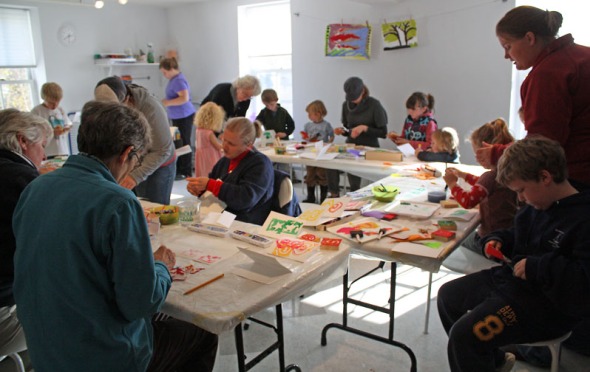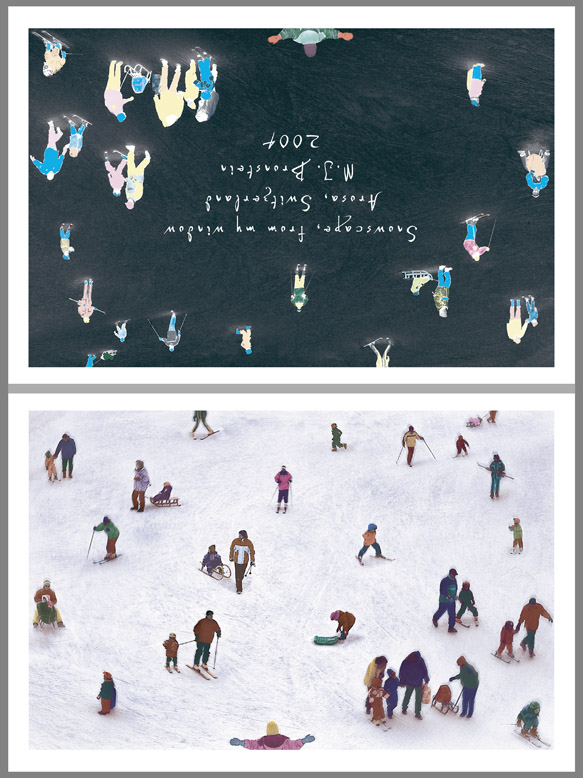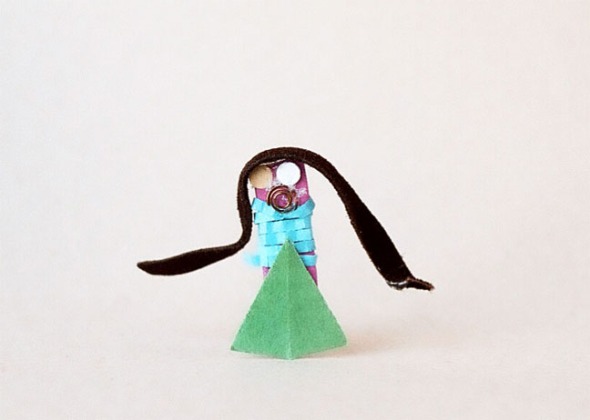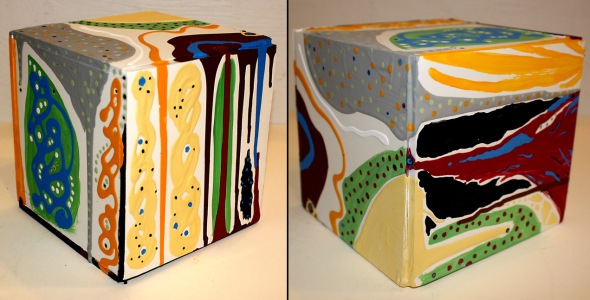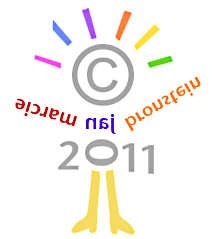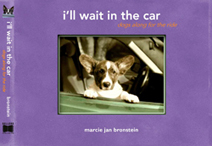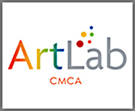stamped impressions
Posted: 11/07/2011 Filed under: art, inspiration, mixed media, workshops | Tags: collaboration, inspiration, mixed media, prompts, workshops Leave a commentSaturday’s Family ArtLab stamping workshop was not only almost standing room only, it was also jam-packed with one gorgeous art-making moment after another. Parents and children in the community created their own stamps, made prints on blank greeting cards, and then embellished the printed cards with watercolors, markers, and crayons.
I set out piles of small wooden blocks (thank you for the donation Viking Lumber!), sheets of adhesive foam, palettes, brushes, tempera, and stacks of blank greeting cards and envelopes. Then, working alone or together, children and their parents dove into their work.
Here is one of the many cards made by the father/daughter team above:
A young girl created this series of cards using a positive stamp (the primary shape) and a negative stamp (the piece of the foam from which the shape came).
Many people made positive and negative stamps and focused on composing their shapes on the card.
Others spent a great deal of time painting or drawing on the stamped images. Here is a dreamy card made by a young girl. She combined the two stamp impressions with beautiful blobs of watercolor.
In the background of the photograph below you see the making of that card… In the foreground there’s a red piece of foam, which I later found when I was cleaning up the room…
I took the piece of foam and made a stamp for myself.
And then I printed some cards and brought them home for my husband and son to complete:
one image, once a year
Posted: 10/30/2011 Filed under: art, inspiration, photography, projects | Tags: inspiration, photography Leave a comment
I knew that November was near, and I had realized that day by day, it had become colder and colder. But I still wasn’t prepared to open my back door to this morning’s snowfall. I think of the obvious (getting out scarves and gloves and coats), but I also think about something that I only think about in the cold month of November: my once-a-year holiday card.
For about 20 years, I’ve sent out a few hundred cards to friends, family, and collectors, with an image I’ve created for the holiday season or for the new year. While I can usually count on a few weeks of total frustration, feeling that I don’t have any ideas that interest me, somehow it always gets resolved. In truth, it’s one of my favorite creative challenges of the year. I take the holiday card seriously because I’m creating and printing one image only, not a series.
I think I might have an idea for this year, and this one, like many, became clear when I was hiking with my friend Pat. (Hiking and yoga and swimming are great creative idea generators.) Hopefully I’ll post this year’s card in a couple of months, but in the meantime, I thought that today, on this snow day, I’d share a small selection of my cards from past years. There is of course a direct reflection in the cards of the arc of my personal photographic work: the use of children’s drawings, negative imagery, and throughout all of the years, hand-colored imagery.
BIG inspiration : BIG magazine
Posted: 10/29/2011 Filed under: artists, children, collaboration, inspiration, press | Tags: artists, collaboration, inspiration, vision Leave a commentA big thank you to Jo Pollitt and Lilly Blue, the creative team behind BIG Magazine, for featuring my work and this Playground on their fabulous blog! If you haven’t yet read (or read about) BIG Kids Magazine you’re in for an inspiring surprise. BIG is an Australian-made biannual contemporary creative arts magazine/blog devoted to promoting creativity and innovative collaboration between and amongst artists and children. Each issue of the magazine features a free artist’s print and two key projects: Side By Side which publishes collaborative artwork by children and artists, and The Child Artist Response Project which is an initiative where children and artists respond directly to each other’s work. You can subscribe to BIG here, like them on their Facebook page here, and, you can submit your child’s artwork to BIG as well!
Bravo BIG!
a child’s vision : eliot bee
Posted: 10/27/2011 Filed under: artists, children, inspiration, mixed media | Tags: artists, inspiration, mixed media, vision 1 CommentIt’s not unusual for a child to make wondrous, unique creations. (All children do.) But it’s rare for a child to make a collection of works that evolve into a cohesive series. Eliot Bee is a five year old girl who has been creating “fairies” out of found objects since before the age of four. In Eliot’s words: I use materials that I find when I’m walking around, or toys I’m not using anymore. I use wooden bodies a lot, but sometimes I use other stuff. I made one from a penny and my daddy’s guitar pick. (See image above.)
I’ve had the great pleasure of working with Eliot many times at the Starrett Center, a wonderful multi-age daycare center in my town. While I’ve never made fairies with her, I’ve watched her approach every other project with the same clear sense of focus and inner direction; a total connection to the materials and the process of creating images or objects.
Eliot began making her fairies at Starrett with her teacher Linda Stec (who is the Executive Director of the Center, as well as a funky and fascinating ceramic artist/puppeteer). It began without fanfare one day, when, not wanting or needing to sleep at nap time, Eliot simply asked: Can I make a fairy? Linda gathered some materials and heated up a hot glue gun.

Then every day like clockwork, for many days and weeks and months thereafter, Eliot made fairies while Linda assisted. Linda’s words to her from the outset were: You’re the artist. I’m just the gluer.
Eliot continued making fairies at home, with her Mom and her Dad. No matter where she worked, the adults were there solely as assistants, ready with a glue gun, but without “suggestions” or directions.
When I first saw Eliot’s collection (months before her one-person show at Waterfall Arts in Belfast last year), I was moved not only by the works themselves, but by the sense that this completely personal work was born of an open environment, where a child’s vision was given infinite space to grow.
{ Many thanks to Eliot’s father, Ethan Andrews, for the photographs in this post. }
freefall : the infinite box project
Posted: 10/21/2011 Filed under: art, artists, books, classes, inspiration | Tags: artists, books, inspiration, mixed media, prompts Leave a commentTomorrow’s daylong workshop at the Center for Maine Contemporary Art is entitled “Shake Up Your Art” for good reason. Adults who are “trying” to make art need shaking up. And what better way to upend stiff, ingrained art-making habits then drawing with crayons? Or inverting the painting you’re making (that you think is so great) so that you can more clearly see what it may be, instead of what you believe it to be? It may sound like the Anything Goes approach to leading a workshop, but there is a method to my madness. A few years ago I read Natalie Goldberg’s seminal work, Writing Down the Bones, which refines and crystallizes the idea of a “writing practice.” In essence, Goldberg encourages writers to “keep your hand moving, lose control, and don’t think.” These ideas, in combination with a her brilliant illumination of the Zen concept of First Thoughts culminated in what is easily one of the most popular books ever written about writing.
At the time of reading Writing Down the Bones, I was looking for a new way to begin my mornings, a way to immediately, without a formal idea or plan, immerse myself in color and shape and form. I honestly can’t remember precisely how I then began making boxes, but I can tell you that like most things that we dive into with curiosity and no expectations, it bloomed into something special.
I created my boxes from squares of foamcore (I have loads of it in my studio because I frame my own photographs), and then approached them with no idea or intent, other than to make a mark, and then respond, with color, shape, line, pattern or texture. These intuitive, spontaneous, unedited, un-erased marks evolved into a unique, free-flowing visual dialogue.
I found that making boxes placed me in a deep state of beginner’s mind, where I was so fully present, that I had no sense of the direction in which a box might move. If only I could step out of my own way, especially when a box seemed to be going in a particular direction, it might become what it wanted to be, as in the box below, which unfortunately seemed to be moving toward a literal writing practice/chakra symbol thing:
Until my very upset friend called me, and we spoke for a long time about the complicated crisis she was navigating. When I returned to my box, I completed it for her, and entitled it My Friend is Having an Awakening.
My collection of boxes grew and grew, and the completion of each one only inspired me to create another. This one is called Flow:
And this is called Lower East Side:
At a certain point I began to use them in my workshops and I immediately saw that I wasn’t alone in feeling captivated by the white box as a canvas.
So tomorrow afternoon, after coloring with crayons and making paintings alone and as a group, and after making collages and drawings prompted by words, the participants in my workshop will be given their own small, white, empty, six-sided box.


